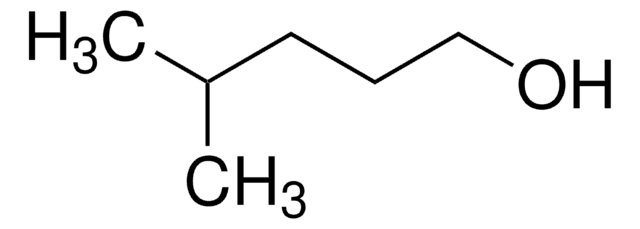おすすめの製品
グレード
ACS reagent
蒸気密度
3 (vs air)
蒸気圧
2 mmHg ( 20 °C)
アッセイ
≥98.5%
形状
liquid
自己発火温度
644 °F
expl. lim.
1.2-9 %, 100 °F
不純物
≤0.002 meq/g Titr. acid
≤0.1% carbonyl (as HCHO)
≤0.2% acids and esters (as amyl acetate)
≤0.5% water
蒸発残留物質
≤0.003%
屈折率
n20/D 1.406 (lit.)
pH
5.6 (20 °C, 25 g/L)
bp
130 °C (lit.)
mp
−117 °C (lit.)
密度
0.809 g/mL at 25 °C (lit.)
SMILES記法
CC(C)CCO
InChI
1S/C5H12O/c1-5(2)3-4-6/h5-6H,3-4H2,1-2H3
InChI Key
PHTQWCKDNZKARW-UHFFFAOYSA-N
類似した製品をお探しですか? 訪問 製品比較ガイド
関連するカテゴリー
詳細
アプリケーション
- Dissolution of a wide range of organic compounds and is often employed for extraction, dilution, and preparation of samples for analysis.
- Starting material or reagent in organic synthesis. It can be incorporated into various reactions to introduce the isoamyl group or alcohol functionality into target molecules.
シグナルワード
Danger
危険有害性情報
危険有害性の分類
Acute Tox. 4 Inhalation - Eye Dam. 1 - Flam. Liq. 3 - Skin Irrit. 2 - STOT SE 3
ターゲットの組織
Respiratory system
保管分類コード
3 - Flammable liquids
WGK
WGK 1
引火点(°F)
110.3 °F - closed cup
引火点(℃)
43.5 °C - closed cup
適用法令
試験研究用途を考慮した関連法令を主に挙げております。化学物質以外については、一部の情報のみ提供しています。 製品を安全かつ合法的に使用することは、使用者の義務です。最新情報により修正される場合があります。WEBの反映には時間を要することがあるため、適宜SDSをご参照ください。
消防法
第4類:引火性液体
第二石油類
危険等級III
非水溶性液体
労働安全衛生法名称等を表示すべき危険物及び有害物
名称等を表示すべき危険物及び有害物
労働安全衛生法名称等を通知すべき危険物及び有害物
名称等を通知すべき危険物及び有害物
Jan Code
320021-6X1L:4548173256542
320021-2L:4548173134512
320021-1L:4548173134499
320021-4X4L:4548173134529
320021-18L:4548173256528
320021-BULK:
320021-20L:4548173134505
320021-4L:
320021-VAR:
320021-2.5L:
320021-500ML:4548173134536
320021-6X500ML:4548173256559
試験成績書(COA)
製品のロット番号・バッチ番号を入力して、試験成績書(COA) を検索できます。ロット番号・バッチ番号は、製品ラベルに「Lot」または「Batch」に続いて記載されています。
この製品を見ている人はこちらもチェック
ライフサイエンス、有機合成、材料科学、クロマトグラフィー、分析など、あらゆる分野の研究に経験のあるメンバーがおります。.
製品に関するお問い合わせはこちら(テクニカルサービス)






